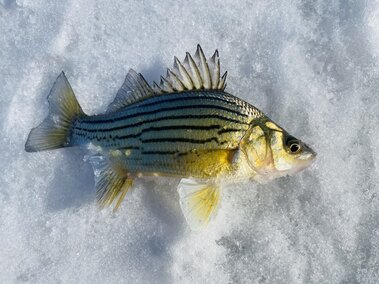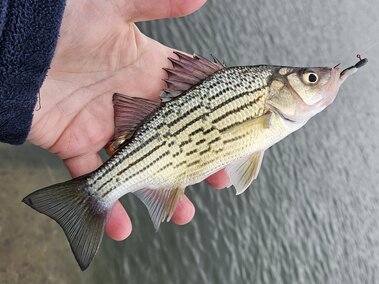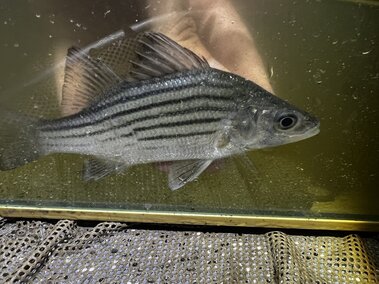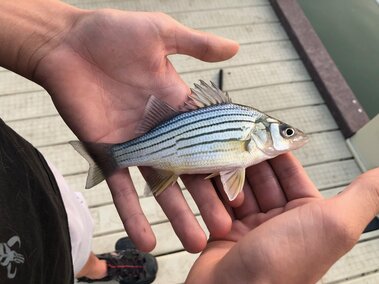Credit: Dominic, some rights reserved (CC-BY), iNaturalist
General Information
Species Name: Morone mississippiensis
Also Known As: paradise bass, striper
Family: Moronidae (Temperate Bass)
Life Span: Up to 6 years
Life Cycle: Yellow bass, like other true basses, are spring spawners. They prefer gravel or rock substrate, but unlike other sea basses they do not appear to require flowing water, and they temporarily pair during spawning. Eggs are usually deposited in two to three feet of water. Eggs are fertilized in the open and receive no care. At water temperatures of 70°F eggs hatch in four to six days.
Origin: Central Mississippi Valley
Injurious: No.
Category 2: Priority Aquatic Invasive Species
Why Are They Invasive?
Yellow bass are very prolific spawners and their populations can increase rapidly. They have the ability to upset the balance in waterbodies as they compete with native fish for food and resources. Once introduced, waterbodies can become overrun with slow-growing, high-density yellow bass populations that limit native species diversity. They not only overpopulate a waterbody, but they also do not reach angler acceptable sizes, often requiring lakes to do a total fish renovation and restocking.
What Do They Look Like?
The yellow bass is silvery-yellow in color overall, with dark green on its back. It has a laterally compressed body, with 6-9 dark horizontal stripes on the sides. Its soft dorsal fin and spinous dorsal fin are connected, and its anal fin has 3 spines and 9-10 soft rays. The back of its tongue lacks teeth. The stripes on the sides of its body are broken and offset above the front of the anal fin, distinguishing it from white bass (Morone chrysops), whose stripes are not offset. It can grow up to 45.7 cm (18 in.) in total length, but rarely reaches lengths greater than 30 cm (12 in.).
Photos
Where Do They Live?
Yellow Bass live in natural lakes, reservoirs and the backwaters of large rivers. It prefers clear to slightly turbid water and a firm bottom substrate of sand, gravel, rock rubble and mud. It is uncommon in abundance, but widespread in the Mississippi River. This fish has historically been distributed in the many man-made lakes and water-supply impoundments. Their origin in these waters is unknown, but probably resulted from fish transported from the Mississippi River. Yellow bass feed heavily on benthic invertebrates that spend much of their life cycle in the bottom substrate. After spawning they move off shore to deeper water. They are usually found in 10 to 20 feet of water using mud flats over large areas of the main lake basin. Here they benefit from benthic invertebrates (blood worms) that thrive in the mucky bottom substrate. Yellow bass move to shallower water in the fall as water temperatures cool. In lakes with emergent vegetation, such as bulrush or cattails, look for them on the outside edge of this protective cover. During the winter, yellow bass are usually found in 6 to 12 feet of water. They move off the shallow areas used in the fall and gather over mud flats where they once again eat bloodworms. They are most active during low-light conditions at sunrise and sunset.
How Do They Spread?
Yellow bass are intentionally stocked in many waterbodies for sportfishing. They are often found in schools, so once anglers catch one, they will usually catch many others.
How Do I Control Them?
Management of invasive fish involving either mechanical removal or application of chemicals to public waters requires a permit. Contact the Contact the Nebraska Game and Parks Commission for more information.
CLEAN your watercraft, trailer, angling gear and other equipment. Remove all aquatic vegetation and animal species from your equipment.
DRAIN your watercraft at the ramp by removing the boat plug and draining all live wells and ballast tanks.
DRY your watercraft, trailer and other equipment for at least 7 days before visiting another waterbody.
DON'T DUMP BAIT. Dispose of bait by emptying bait buckets on dry land, away from waterbodies or in a trash receptacle. Moving a live organism from one waterbody to another is illegal, even if you are planning to use the organism as bait.
DON'T LET IT LOOSE. Do not release or transport exotic or non-native fish species to new ecosystems. It is unlawful to release any aquatic species into a waterbody other than the one from which it was harvested. Doing so can promote the spread of AIS.
What Should I Do If I See Them in Nebraska?
If you see yellow bass in Nebraska, you should report them to the Nebraska Game and Parks Commission's Aquatic Invasive Species (AIS) Program using their AIS Report Form. For guidance on what information to include in your report, check out our reporting tips.
References and More Information
Iowa Department of Natural Resources
Minnesota Department of Natural Resources
Nebraska Game and Parks Commission
Smithsonian Tropical Research Institute
USGS Nonindigenous Aquatic Species
Weisman, S. (2024). Fight continues against yellow bass in some of Iowa's lakes. Outdoor News.
Woten, R. (2025). Yellow Bass Iowa’s Overlooked Panfish. The Iowa Sportsman.




